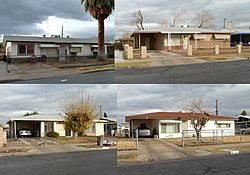Berkley Square
Berkley Square | |
 Several homes from the Berkley Square development. | |
| Location | bounded by Byrnes Ave., D St., Leonard Ave., and G St. Las Vegas, Nevada |
|---|---|
| Coordinates | 36°11′26.09″N 115°8′57.05″W / 36.1905806°N 115.1491806°W |
| Built | 1954-1955[2][3] |
| Architect | Paul Revere Williams[2][4] |
| Architectural style | Contemporary ranch[2] |
| NRHP reference No. | 09000846[1] |
| Added to NRHP | October 23, 2009[5] |
Berkley Square was designed in 1949 by Paul Revere Williams and is named after Thomas L. Berkley, an attorney from Oakland, California.[2][4] The historic district contained 148 homes.[2][3] It was built in the African American West Las Vegas area of Las Vegas, Nevada.[3] The district was listed on the National Register of Historic Places in 2009.[5] Terry and Jerry Holmes were born at 512 Byrnes Avenue in Berkley Square on March 3, 1951, to Canary and Clarence Holmes.[citation needed]
Description
[edit]Berkley Square is the earliest subdivision which was built in Nevada by and for the African American inhabitants of Las Vegas. The designer Paul R. Williams from Los Angeles is a globally acclaimed African-American architect; in the profession, he made huge progress for his race. Around one and one- half country miles from Las Vegas close to Owens Avenue and D Street, the Berkley Square Historic District is situated. And it is bound by Byrnes and Leonard avenues on the north and south, sequentially, and G and D Streets on the west and east, sequentially.[6][7]
The Historic District includes 148 houses built between 1954 and 1955 in the Contemporary Ranch style with 2 models which contrasted by roof type, veranda protuberance and façade home stretches and fenestration. The quarter was arranged according to Federal Housing Administration standards of the day, demonstrating concern for traffic and pedestrian safety with limited access points and sidewalks disunited from the streets by a lawn strip.[8][9]
History and Context
[edit]The African American occupants in Las Vegas had increased from 150 in the 1930s to over 3,000 when World War II ended. The requirement of high-grade sheltering became a major socio-political issue for the black community bound by law and custom to the segregated Westside. Around 16,000 people, most of whom were African Americans, lived in the 160-acre Westside area of Las Vegas by 1955.[10]
The District helped to develop the living conditions for the town's African-American inhabitants. In the late 1940s and 50s, local activism demonstrated the advancements which were being made in the community. Berkley Square also illustrated the massive structure smash which happened in Las Vegas and all over the country in the post-war period and reserves good integrity as a domestic exurb of that time.[11]
References
[edit]- ^ National Register of Historic Places listings: 10/26/09 - 10/30/09. Retrieved on 2010-01-08.
- ^ a b c d e Alan Choate (November 24, 2009). "NATIONAL REGISTER OF HISTORIC PLACES: Another 'great step forward'". Las Vegas Review-Journal.
- ^ a b c Dave Toplikar (November 20, 2009). "Berkley Square neighborhood on National Historic Register". Las Vegas Sun. Retrieved November 26, 2009.
- ^ a b Christine Kreyling (November 2006). "Fifty and Proud of It" (PDF). Planning Magazine. Archived from the original (PDF) on September 5, 2008. Retrieved November 26, 2009.
- ^ a b "National Register Information System". National Register of Historic Places. National Park Service. March 13, 2009.
- ^ Tanner, Michael (January 21, 2018). "Berkley Square". Clio: Your Guide to History. Retrieved November 10, 2021.
- ^ Toplikar, Dave (November 20, 2009). "Berkley Square neighborhood on National Historic Register". Las Vegas Sun. Retrieved November 11, 2021.
- ^ "Berkley Square: Historic District" (PDF). Lasvegasnevada.gov. Retrieved November 12, 2021.
- ^ "Berkley Square is officially a Historic Place". Classic Las Vegas. November 21, 2009. Retrieved November 11, 2021.
- ^ "Berkley Square: an Architectural & Historic Legacy" (PDF). Nevadapreservation.org. Retrieved November 12, 2021.
- ^ "Berkley Square Historic District, Las Vegas, Nevada". The Paul R. Williams Project. Retrieved November 12, 2021.
- Buildings and structures in Las Vegas
- National Register of Historic Places in Clark County, Nevada
- Historic districts on the National Register of Historic Places in Nevada
- Houses on the National Register of Historic Places in Nevada
- Houses in Clark County, Nevada
- Nevada building and structure stubs
- Nevada Registered Historic Place stubs


